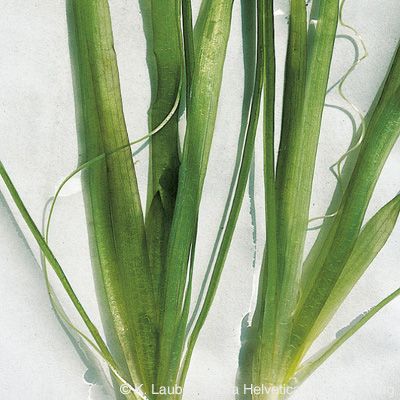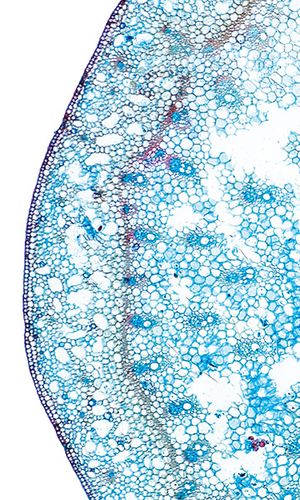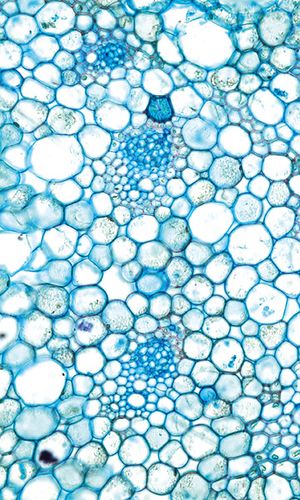Vallisneria spiralis L.
1048800
Species
ISFS : 437700
Checklist : 1048800
ISFS : 437700
Checklist : 1048800
Contains :
Synthesis
Species description (© Flora Helvetica 2018)
Untergetauchte Wasserpflanze mit grundständigen, bandförmigen, 5-10 mm breiten und bis 80 cm langen, flutenden Blättern. Zweihäusig. Blüten weiss, die männlichen in Knäueln, Durchmesser ca. 1 mm, sich von der Pflanze trennend und auf der Wasseroberfläche sich öffnend. Weibliche Blüten einzeln, Durchmesser 2-3 mm, auf langen, die Oberfläche erreichenden, vor und nach dem Blühen schraubig gewundenen Stielen.Flowering period (© Flora Helvetica 2018)
7-10Habitat and distribution inside Switzerland (© Flora Helvetica 2018)
Stehende und langsam fliessende, 1-2 m tiefe, kalkarme Gewässer / kollin / Im südlichen TI eingebürgertWorld distribution (© Flora Helvetica 2018)
Aus den Tropen stammende AquarienpflanzeEcological indicator (© Landolt & al. 2010)
5u22-351.a.2n=20(40)Status
IUCN status
Near threatenedNational Priority
K - no national priorityInternational responsibility
K - noneConservation
Threats
Anatomy
Summary of stem anatomy (German)
Umriss rund oder oval. Leitbündel diffus verteilt. Grosse, unregelmässige Intercellularen. Epidermiszellen verholzt.Description
Culm-diameter 5-10 mm, center full, radius of culm in relation to wall thickness 1:1. Outline circular with a smooth surface. Culm-center full, containing unlignified cells. Culm without endodermis but with a sheath of lignified cells around the center. Epidermis cells thin-walled all around. Large vascular bundles distributed in the whole culm. Chlorenchyma present, continuous peripheral belt with unlignified round cells (like a large cortex). Sclerenchyma belt in a small, peripheral continuous belt (< 4 cells). Cells medium thick-walled. Vascular bundles collateral closed. Sheath around vascular bundles absent or not lignified. Vessel arrangement irregularly grouped or distributed. Aerenchyma (intercellulars) between parenchyma cells irregular and large.Distribution map
Habitat and distribution inside Switzerland
Im südlichen TI eingebürgertWorld distribution
Aus den Tropen stammende AquarienpflanzeEcology
Life form
Hydrophyte
Habitats
Milieux Phytosuisse (© Prunier et al. 2017)
Habitats © Delarze & al. 2015
 | 1.1.2 - Laichkrautgesellschaften (Potamion) |
bold
Dominant species, influencing the appearance of the habitat
 Character species
Character species
 Less strictly linked to a specific habitat
Less strictly linked to a specific habitat
Ecological indicator values by © Landolt & al. (2010)
| Soil factors | Climatic factors | Salinity tolerance | |||
|---|---|---|---|---|---|
| Humidity Value H | 5u | Light Value L | 3 | Salinity Index | -- |
| Reaction Value R | 2 | Temperature factor T | 5 | ||
| Nutriments value N | 2 | Continentality K | 1 | ||
- Ecological values legend
Humidity Value H 1 very dry 1+ dry 2 moderatly dry 2+ moist 3 medium wet 3+ wet 4 very wet 4+ soggy 5 submerged or underwater f plants living in running water u mostly submerged plants v partly submerged, partly floating plants w humidity moderately variable (± scale of 1-2) w+ highly variable humidity (scale exceeding ± 2) Reaction Value R 1 Very acid (pH 2.5-5.5) 2 acid (pH 3.5-6.5) 3 lightly acid to neutral (pH 4.5-7.5) 4 neutral to basic (pH 5.5-8.5) 5 basic (pH 6-5 -> 8.5 Nutriments value N 1 very low in nutrients 2 low in nutriments 3 medium-poor to medium-rich in nutrients 4 rich in nutriments 5 very rich in nutriments Salinity tolerance 1 halotolerant 3 halophyle Light Value L 1 very shady 2 shady 3 lighted areas 4 luminous 5 highly luminous Temperature factor T 1 alpine to nival stages (from the treeline to the snowline) 1+ suprasubalpine and upper subalpine levels (pine and larch forests) 2 subalpine level (coniferous forests without beeches up to the upper limit of spruces) 2+ lower subalpine and upper mountain stages 3 mountain level (beech and silver fir forests, in the central Alps Scots pine forests) 3+ lower mountain and upper hill levels 4 hill level (mixed deciduous oak forests) 4+ hot places, hill level 5 very hot places, hill level (only in the hottest places, typical of southern Europe) Continentality K 1 Atlantic (high air humidity, very low temperature variations, mild winters) 2 Sub-Atlantic (high air humidity, low temperature variations, relatively mild winters) 3 sub-Atlantic to subcontinental (average air humidity, moderately variable temperature, slightly low winter temperatures) 4 subcontinental (low air humidity, large temperature variations, rather cold winters) 5 continental (very low air humidity, very large temperature variations, cold winters)
Water dependency
| Rivers | |
| Calm water | |
| Ground water |
Nomenclature
Accepted Name (Checklist 2017)
Vallisneria spiralis L.
Vernacular name
Deutscher Name :
WasserschraubeNom français :
Vallisnérie en spiraleNome italiano :
VallisneriaMatch with other reference books
| Relation | Nom | Book | No |
|---|---|---|---|
| = | Vallisneria spiralis L. | Checklist 2017 | 437700 |
| = | Vallisneria spiralis L. | Flora Helvetica 2001 | 2390 |
| = | Vallisneria spiralis L. | Flora Helvetica 2012 | 2381 |
| = | Vallisneria spiralis L. | Flora Helvetica 2018 | 2381 |
| = | Vallisneria spiralis L. | Index synonymique 1996 | 437700 |
| = | Vallisneria spiralis L. | Landolt 1977 | 158 |
| = | Vallisneria spiralis L. | Landolt 1991 | 149 |
| = | Vallisneria spiralis L. | SISF/ISFS 2 | 437700 |
| = | Vallisneria spiralis L. | Welten & Sutter 1982 | 2027 |
= The taxon corresponds to the accepted taxon (Checklist 2017)
< The taxon is included in the accepted taxon (Checklist 2017)
> The taxon includes (among others) also the accepted taxon (Checklist 2017)
< The taxon is included in the accepted taxon (Checklist 2017)
> The taxon includes (among others) also the accepted taxon (Checklist 2017)
Status
Native status
-IUCN list of endangered species (© Walter & Gillett 1997) : No
Status on national Red List 2016
IUCN status:
Near threatened

Additional information
IUCN criteria: D2
Status on regional Red List 2019
| Biogregraphic regions | Status | IUCN criteria |
|---|---|---|
| Jura (JU) | -- | |
| Mittelland (MP) | NA | |
| Alpennordflanke (NA) | -- | |
| Alpensüdflanke (SA) | NT | D2 |
| Östliche Zentralalpen (EA) | -- | |
| Westliche Zentralalpen (WA) | -- |
- Legend
EX Extinct RE Regionally Extinct CR(PE) Critically Endangered, Probably Extinct CR Critically Endangered EN Endangered VU Vulnerable NT Near Threatened LC Least Concern DD Data Deficient NE Not Evaluated NA Not Applicable
National Priority Species List Status
| No national priority or international responsability |
Protection status
| No international, national or cantonal protection |
- Disclaimer
InfoFlora compiles information on protected species as accurately as possible, taking it from the respective cantonal laws. In some cases, however, it was not possible to use the plant names as listed in the original text, but an interpretation of their taxonomy or nomenclature was necessary. The exact meaning of the categories „completely protected“ and „partially protected“ differs among the cantons.
InfoFlora cannot guarantee that the information on the protection status is correct and complete. In case of doubts, we recommend to look up the texts of the respective cantonal law.
Status by sector of activity
| Agriculture-related environmental objectives : | more informations | |
| Forest management environmental objectives : | more informations |


